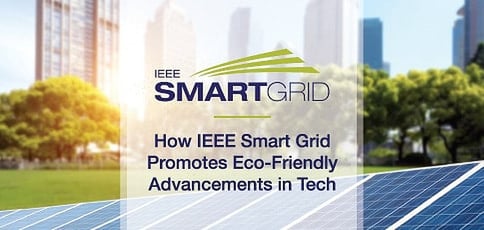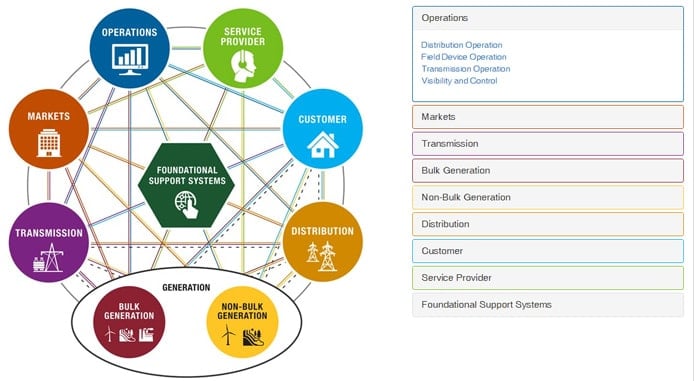
TL; DR: Unifying 14 societies focused on computing, control systems, instrumentation, energy, and more, the Institute of Electrical and Electronics Engineers and its first initiative, IEEE Smart Grid, aim to modernize and optimize the world’s power grid. By providing a collaborative space for industry leaders to brainstorm, share research developments, and gather knowledge, IEEE Smart Grid promotes the framework for energy-efficient and eco-friendly innovations that benefit global populations.
Even though Project Manager Angelique Rajski Parashis has worked with the Power and Energy Society of the Institute of Electrical and Electronics Engineers for five years, she still gets a little starstruck at times.
The society runs the IEEE Smart Grid initiative, which brings together 14 IEEE organizational units to reach a shared goal of improving the world’s power systems. Experts and industry leaders in computing, control systems, electrical insulation, instrumentation, electronics, signal processing, and vehicular technology collaborate and share information to develop standards, publications, and educational opportunities.
Among the leaders is University of Minnesota professor Massoud Amin, considered the father of the smart grid. Massoud, who has taught and researched power grid theories for nearly three decades, chairs the IEEE Smart Grid Initiative.
“It’s pretty cool to work with all of these really smart people in all of these areas,” Angelique said. “When you see them in a room talking to each other, it’s kind of mesmerizing.”
Fostering a Collaborative Space for 14 IEEE Societies
IEEE, the world’s largest association of technical professionals, boasts more than 430,000 members and publishes a third of the world’s technical literature in electrical engineering, computer science, and electronics. Of the organization’s 46 societies, 14 signed up to join the first of 20-some IEEE initiatives, created to encompass and capitalize on the wide array of specialties among the societies. IEEE Smart Grid facilitates related publications, educational opportunities, standards, best practices, and conferences.
“We also provide a collaborative space for them to come together and do some brain sharing,” Angelique said. “It really offers everyone a place at the table to talk about smart grids and how they can become bigger and better.”
A smart grid, according to Massoud, can self-heal with real-time monitoring and reactions to constantly predict and adapt to issues. A more modern, reliable grid would shorten and reduce power outages, detect online attacks, and minimize the impact of disturbances.
Each month, Angelique and IEEE Smart Grid coordinate webinars, interviews, newsletters, tutorials, and articles about a particular issue within the smart grid realm.
“We’re really the go-to place for people to visit on any aspect they might be interested in learning about Smart Grid,” she said. “The initiative has experts in the field who provide a really holistic view of what the smart grid is in its different forms.”
Creating and Evolving the Smart Grid Framework
The Energy Independence and Security Act in 2007 tasked the National Institute of Standards and Technology (NIST) with developing a framework for the managing and sharing of information to assure interoperability of smart grid devices and systems. The act named IEEE as one of the organizations to develop and contribute standards.
A few years ago, according to Angelique, IEEE Smart Grid revisited the NIST Conceptual Module and enhanced it into what is currently known as the IEEE Smart Grid Domains and Sub-Domains.

IEEE Smart Grid identified nine domains and 32 subdomains to organize members’ work around the smart grid.
“NIST had a similar framework, but our members enhanced it a little bit and added some more meat to the bones,” she said.
The IEEE Smart Grid framework identifies nine domains and 32 subdomains. In addition to dividing the energy generation domain into conventional and distributed energy resources domains, IEEE Smart Grid leaders added a domain for foundational support systems. Each of the subdomains focuses on major processes conducted day to day within the energy industry; examples include substation automation, asset management, customer enablement, communication systems, and system resiliency.
“What’s pretty cool is the people who worked on the original NIST framework also worked on our new framework,” Angelique said. “They went back to NIST, and now they’re improving their structure as we continue to improve ours. It’s cool to see that evolution in the industry of how you define the smart grid.”
Committees Engage Volunteers in Education, Research, and Publications
IEEE Smart Grid volunteers participate through committees; steering and operations committees focus on day-to-day processes, while other committees concentrate efforts on specific areas, including education, marketing, policy technical support, publications, and research and development. Each committee meets either biweekly or monthly.
The education committee hosts two webinars each month, concentrated on a particular domain or subdomain of the smart grid framework. The webinars, which are free to join, garnered more than 400 attendees on average in 2017 so far.
In collaboration with IEEE Power and Energy Society, the education committee also hosts four Innovative Smart Grid Technologies conferences around the world.
Interviews, articles, videos, and webinars can be found in IEEE Smart Grid’s resource center. Content is free for members of the 14 participating IEEE organizational units, while other IEEE members and non-members must register and pay a fee.
Modernizing and Optimizing the Power Grid for Smart Cities and Villages
When IEEE Power and Energy Society began administering the IEEE Smart Grid Initiative a few years ago, roughly 43,000 people followed the consortium through four marketing channels. Now, more than 146,000 people engage with IEEE Smart Grid on twice as many channels. According to Angelique, the initiative aims to reach more than 151,000 followers by the end of the year.

IEEE Smart Grid members partner with related initiatives seeking to improve the power supply around the world.
Angelique and IEEE Power and Energy also oversee two newer, smart grid-related initiatives. IEEE Smart Cities combines technological, governmental, and societal interests to create intelligent and sustainable urban environments that reduce environmental impact as the world’s population is expected to double by 2050.
IEEE Smart Village, under the direction of Mike Wilson, seeks to reach the roughly 4 billion people living without reliable access to electricity. The initiative educates residents and creates sustainable, affordable, and locally owned micro-utilities.
“IEEE Smart Village works on the rural education of people in third-world countries where there is no electricity,” Angelique said. “They actually go in there and install systems and teach local people how to be sustainable and prosperous themselves.”
IEEE Smart Village provides community charging stations, training, and support to local entrepreneurs, who in turn lease portable battery kits to homeowners. The initiative currently serves more than 50,000 people in 34 villages in Haiti, Nigeria, Cameroon, South Sudan, Kenya, Zambia, and India.
“We’re going to be doing the same things with these initiatives as we’ve done to grow IEEE Smart Grid,” Angelique said. “It’s all for creating the standards, knowledge, and engagement for improving the world.”
HostingAdvice.com is a free online resource that offers valuable content and comparison services to users. To keep this resource 100% free, we receive compensation from many of the offers listed on the site. Along with key review factors, this compensation may impact how and where products appear across the site (including, for example, the order in which they appear). HostingAdvice.com does not include the entire universe of available offers. Editorial opinions expressed on the site are strictly our own and are not provided, endorsed, or approved by advertisers.
Our site is committed to publishing independent, accurate content guided by strict editorial guidelines. Before articles and reviews are published on our site, they undergo a thorough review process performed by a team of independent editors and subject-matter experts to ensure the content’s accuracy, timeliness, and impartiality. Our editorial team is separate and independent of our site’s advertisers, and the opinions they express on our site are their own. To read more about our team members and their editorial backgrounds, please visit our site’s About page.

